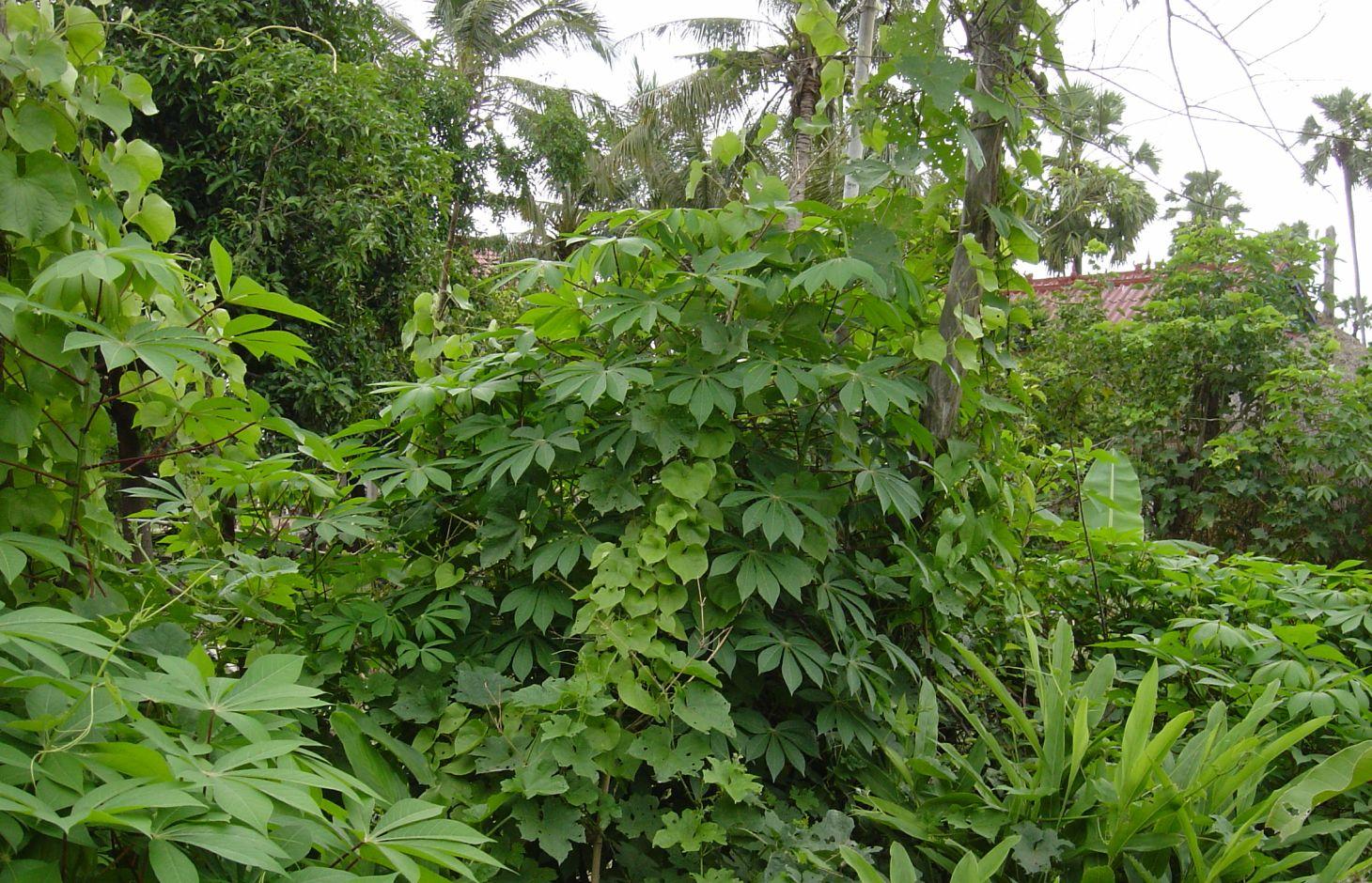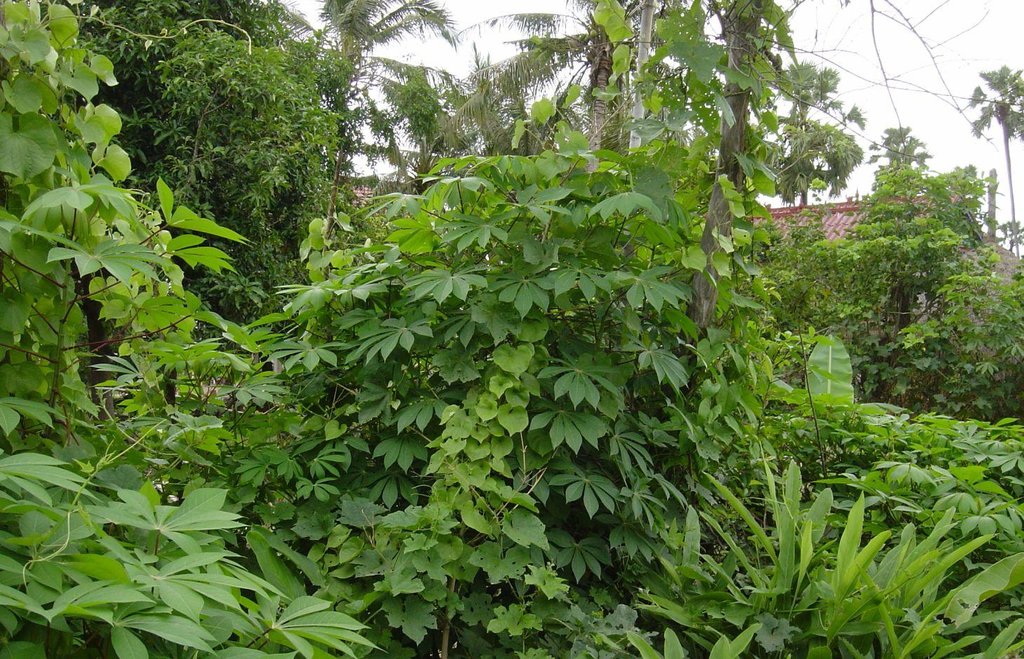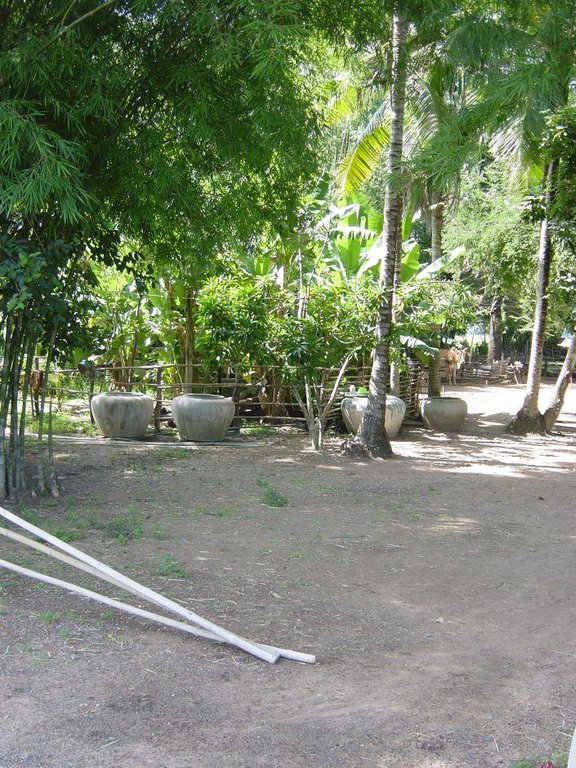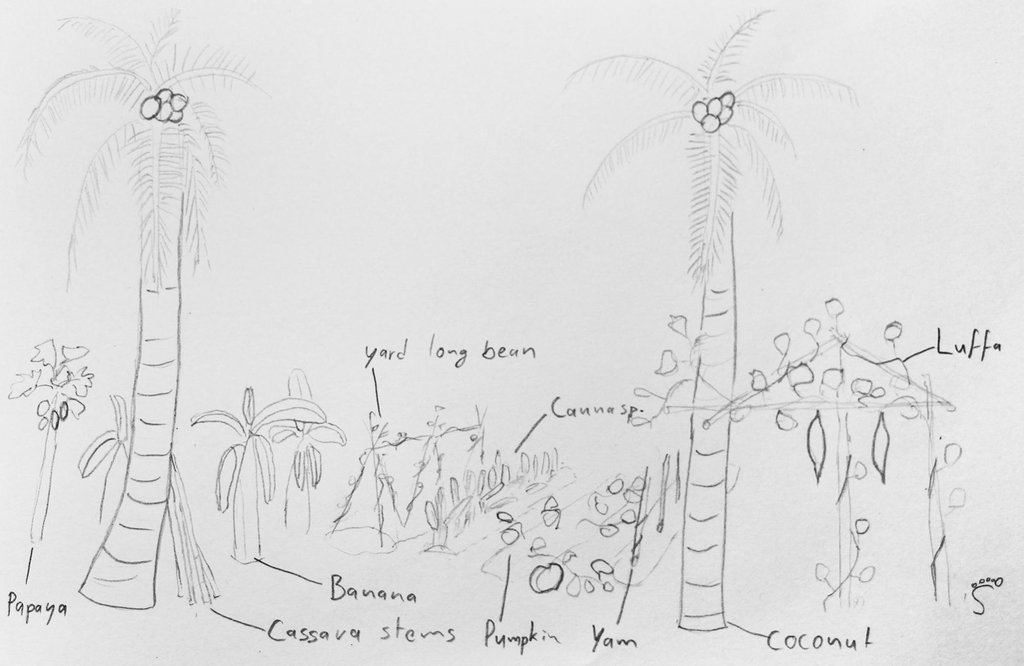Home gardens for consumption and cash crop production [Cambodge]
- Création :
- Mise à jour :
- Compilateur : Stefan Graf
- Rédacteur : –
- Examinateurs : Deborah Niggli, Alexandra Gavilano
ច្បារដំណាំ (Khmer)
technologies_1628 - Cambodge
Voir les sections
Développer tout Réduire tout1. Informations générales
1.2 Coordonnées des personnes-ressources et des institutions impliquées dans l'évaluation et la documentation de la Technologie
Spécialiste GDT:
Khun Lean Hak
SOFDEC/LAREC, www.sofdec.com
Cambodge
1.3 Conditions relatives à l'utilisation par WOCAT des données documentées
Le compilateur et la(les) personne(s) ressource(s) acceptent les conditions relatives à l'utilisation par WOCAT des données documentées:
Oui
1.4 Déclaration sur la durabilité de la Technologie décrite
Est-ce que la Technologie décrite ici pose problème par rapport à la dégradation des terres, de telle sorte qu'elle ne peut pas être déclarée comme étant une technologie de gestion durable des terres?
Non
2. Description de la Technologie de GDT
2.1 Courte description de la Technologie
Définition de la Technologie:
Home gardens, containing tree, shrub, herbs, vine, tuber layers as well as poultry, produce food for household consumption as well as an additional income.
2.2 Description détaillée de la Technologie
Description:
Home gardens are a traditional setting in Cambodia, where they appear around nearly each house. All the seven layers of production occur, with a tree canopy, lower trees, shrubs, herbs, a soil cover, roots and tubers as well as a climbing layer, but not all layers can be found in each garden. The overlapping production allows a high productivity on a small area, and the trees/canopy provide a comfortable microclimate for both humans and livestock. The products of the home gardens are consumed by the family, surplus is given to neighbours or sold, and provide an additional income. One or more of the crops are produced in bigger amounts to serve as a cash crop. It can be coconuts close to the city, mangoes that are processed, sugarcane or vegetables like winged beans for the market, bamboo for handicrafts or constructions. Poultry is free ranging in the home gardens, thus when short annual plants like water spinach are planted they are protected with bamboo or net fences. The poultry, mostly chicken, but as well ducks, Muscovy ducks, and others, forages in the waste and eats bugs and worms.
The home gardens are planted to produce food, to provide additional income source and assure a comfortable microclimate. Medicinal plants, as well as plants for handicrafts like bamboo, are grown in the home gardens. Due to a lack of labour availability on the farms, the gardens are only poorly maintained. Some NGOs try to implement the production of more annual crops in the home gardens, but fail due to this constraint and the fact that leafy vegetables are collected from the wild during the wet season.
When a new house is built, canopy trees like coconuts or sugar palms are planted, sometimes following a square pattern, with other trees in between. In other gardens, no pattern can be found, as trees are planted more randomly, or left growing on their own. The seedlings growing in and around trash piles are transplanted to more suitable places, sometimes seedlings from grafted varieties are bought from the market.
Mainly annual crops, like yam, are fertilized with cow manure or compost before the sowing. Due to a lack of irrigation water, most farmers only grow annuals during the wet season. During the dry season, the vegetables are bought from other provinces or countries.
The analysed area is flat (slope < 2%), tropic (dry and wet season), and the soils are mostly sandy or loamy. The soils on the fields contain little organic matter (low soil fertility, acidification, small amount of cattle, area has been deforested a long time ago) and the groundwater table is rather high (2 m below soil level during the dry season, on the surface during the wet season).
Due to climate change, the rainfalls are more erratic, temperatures rise and droughts are more recurrent. Rice is the predominant crop grown in the area, since it serves as staple food (mix subsistence and commercial activities). Rice is often grown in monocultures and harvested once a year. Once the rice is harvested (dry season), some farmer release cattle to the paddy fields to eat the straw and weeds.
As an addition to rice, most land users grow vegetable and fruits in home gardens (subsistence) and complement their income by producing handicrafts or through off-farm income / remittances from family members working in other places. Gathering of wild food (plants, animals, and mushrooms) is also of importance for the diet. The increasing migration rate (the young generation leaves the villages to work in the cities, garment industry or abroad) results in a decrease of available labour force in the area that has detrimental effects on the agricultural activities. Furthermore, the civil war in the 1970s (Khmer Rouge) led to the loss of agricultural knowledge that different NGOs try to re-establish.
2.3 Photos de la Technologie
2.5 Pays/ région/ lieux où la Technologie a été appliquée et qui sont couverts par cette évaluation
Pays:
Cambodge
Région/ Etat/ Province:
Kampong Chhnang
Spécifiez la diffusion de la Technologie:
- répartie uniformément sur une zone
S'il n'existe pas d'informations exactes sur la superficie, indiquez les limites approximatives de la zone couverte:
- 10-100 km2
Commentaires:
There is a smooth transition between home gardens and orchards, as well as between home gardens and commercial garden. Thus a quantification of the area is difficult. But around 10 % of the village areas are used as home gardens.
2.6 Date de mise en œuvre de la Technologie
Si l'année précise est inconnue, indiquez la date approximative: :
- il y a plus de 50 ans (technologie traditionnelle)
2.7 Introduction de la Technologie
Spécifiez comment la Technologie a été introduite: :
- dans le cadre d'un système traditionnel (> 50 ans)
Commentaires (type de projet, etc.) :
There have always been home gardens. There is a lot of research carried out, with species and varieties spreading among farmers. Some NGOs also try to implement the production of more annual vegetables in the home gardens, but they are abandoned as soon as the NGOs leave.
3. Classification de la Technologie de GDT
3.1 Principal(aux) objectif(s) de la Technologie
- améliorer la production
- créer un impact économique positif
3.2 Type(s) actuel(s) d'utilisation des terres, là où la Technologie est appliquée
Les divers types d'utilisation des terres au sein du même unité de terrain: :
Oui
Précisez l'utilisation mixte des terres (cultures/ pâturages/ arbres):
- Agroforesterie

Terres cultivées
- Cultures annuelles
- Cultures pérennes (non ligneuses)
- Plantations d’arbres ou de buissons
Cultures annuelles - Précisez les cultures:
- céréales - riz (de milieux secs)
- plantes à racines et à tubercules - patates douces, igname, taro, colocase, autres
- plantes à racines et à tubercules - manioc
- légumes - melon, citrouille, courge ou cucurbitacées
Cultures pérennes (non ligneuses) - Précisez les cultures:
- bananier/plantain/abaca
Plantations d'arbres et d'arbustes - Précisez les cultures:
- citron
- noix de coco (fruits, fibre, feuilles, etc.)
- fruits, autres
- manguier, mangostane, goyave
- papaye
Précisez:
Longest growing period in days: 210, Longest growing period from month to month: June to December

Forêts/ bois
Type d’arbres:
- Bambou commun
Commentaires:
Major land use problems (compiler’s opinion): Overgrazing, low soil fertility, sandy soils, monocultures, soil left bare after ploughing, wind and dust storms, climate change.
Major land use problems (land users’ perception): Lack of water in the dry season, low soil fertility.
Type of cropping system and major crops comments: Cash and food crops depend highly on personal preferences.
3.4 Approvisionnement en eau
Approvisionnement en eau des terres sur lesquelles est appliquée la Technologie:
- mixte: pluvial-irrigué
3.5 Groupe de GDT auquel appartient la Technologie
- agroforesterie
- apiculture, aquaculture, élevage de volailles, de lapins, du ver à soie, etc.
- Jardins/ potagers familiaux
3.6 Mesures de GDT constituant la Technologie

pratiques végétales
- V1: Couverture d’arbres et d’arbustes
- V2: Herbes et plantes herbacées pérennes
Commentaires:
Type of vegetative measures: scattered / dispersed
3.7 Principaux types de dégradation des terres traités par la Technologie

érosion éolienne des sols
- Et: perte de la couche superficielle des sols (couche arable)

dégradation chimique des sols
- Cn: baisse de la fertilité des sols et réduction du niveau de matière organique (non causée par l’érosion)
- Ca: acidification

dégradation hydrique
- Ha: aridification
- Hg: changement du niveau des nappes phréatiques (eaux souterraines) et des aquifères
Commentaires:
Main causes of degradation: soil management (Soil left bare after ploughing), crop management (annual, perennial, tree/shrub) (Monocultures of annual crops (rice))
Secondary causes of degradation: overgrazing (Uncontrolled grazing on fallow fields), change in temperature (More hot days, climate change), wind storms / dust storms (Human induced dust storms, wind storms due to climate change.), droughts (Climate change), labour availability (High migration rates), education, access to knowledge and support services (Agricultural knowledge lost during the Khmer Rouge Regime.), war and conflicts (Agricultural knowledge lost during the Khmer Rouge Regime.)
3.8 Prévention, réduction de la dégradation ou réhabilitation des terres dégradées
Spécifiez l'objectif de la Technologie au regard de la dégradation des terres:
- prévenir la dégradation des terres
- réduire la dégradation des terres
4. Spécifications techniques, activités, intrants et coûts de mise en œuvre
4.1 Dessin technique de la Technologie
Spécifications techniques (associées au dessin technique):
Example of a homegarden with different layers. Coconut palms present the top layer, different vines grow on trellises, bananas and a dwarf papaya form an intermediate layer, pumpkins form the soil cover and Canna represents the edible roots. Many edible wild plants would grow by themselves between the planted ones, and would also be consumed.
Kampong Chhnang
Date: 2014
Technical knowledge required for field staff / advisors: moderate
Technical knowledge required for land users: moderate (Each garden is different.)
Main technical functions: improvement of ground cover, increase in organic matter, increase in nutrient availability (supply, recycling,…), increase of biomass (quantity), promotion of vegetation species and varieties (quality, eg palatable fodder), spatial arrangement and diversification of land use
Secondary technical functions: water harvesting / increase water supply, improvement of water quality, buffering / filtering water, sediment retention / trapping, sediment harvesting, reduction in wind speed
Scattered / dispersed
Vegetative material: T : trees / shrubs, F : fruit trees / shrubs, C : perennial crops
Number of plants per (ha): n/a
Fruit trees / shrubs species: Sugar palm, coconut, mango, custard apple, bananas, limes.
Perennial crops species: Lemon grass, bamboo.
Other species: Eggplants, winged beans, yard long beans, pumpkins, cucumbers.
Auteur:
Stefan Graf, Switzerland
4.2 Informations générales sur le calcul des intrants et des coûts
Indiquez le coût salarial moyen de la main d'œuvre par jour:
5.00
4.3 Activités de mise en place/ d'établissement
| Activité | Calendrier des activités (saisonnier) | |
|---|---|---|
| 1. | Planting of the selected trees and other plants. | Whole year |
4.4 Coûts et intrants nécessaires à la mise en place
| Spécifiez les intrants | Unité | Quantité | Coûts par unité | Coût total par intrant | % du coût supporté par les exploitants des terres | |
|---|---|---|---|---|---|---|
| Main d'œuvre | Labour | 1,0 | 10,0 | 10,0 | 100,0 | |
| Equipements | Tools | 1,0 | 20,0 | 20,0 | 100,0 | |
| Matériel végétal | seeds | 1,0 | 5,0 | 5,0 | 100,0 | |
| Matériel végétal | seedlings | 1,0 | 45,0 | 45,0 | 100,0 | |
| Coût total de mise en place de la Technologie | 80,0 | |||||
| Coût total de mise en place de la Technologie en dollars américains (USD) | 80,0 | |||||
4.5 Activités d'entretien/ récurrentes
| Activité | Calendrier/ fréquence | |
|---|---|---|
| 1. | Harvesting | Depends on the size of the garden and the crops. |
| 2. | Planting and fertilizing | Depends on the farmers' preference for a given crop |
4.6 Coûts et intrants nécessaires aux activités d'entretien/ récurrentes (par an)
| Spécifiez les intrants | Unité | Quantité | Coûts par unité | Coût total par intrant | % du coût supporté par les exploitants des terres | |
|---|---|---|---|---|---|---|
| Main d'œuvre | labour | 1,0 | 60,0 | 60,0 | 100,0 | |
| Matériel végétal | seeds | 1,0 | 3,0 | 3,0 | 100,0 | |
| Coût total d'entretien de la Technologie | 63,0 | |||||
| Coût total d'entretien de la Technologie en dollars américains (USD) | 63,0 | |||||
Commentaires:
Machinery/ tools: Depending on the planted crops a knife, hatchet, spate and hoe.
The costs were calculated for 2014 for an “average” home garden that is newly established on a cleared land. It is not based on one case study, but on discussions with many farmers.
4.7 Facteurs les plus importants affectant les coûts
Décrivez les facteurs les plus importants affectant les coûts :
The labour is the most expensive in the home gardens. This is problematic as the labour availability is decreasing due to high migration rates.
5. Environnement naturel et humain
5.1 Climat
Précipitations annuelles
- < 250 mm
- 251-500 mm
- 501-750 mm
- 751-1000 mm
- 1001-1500 mm
- 1501-2000 mm
- 2001-3000 mm
- 3001-4000 mm
- > 4000 mm
Spécifications/ commentaires sur les précipitations:
1486.45 mm 2013 in Kampong Chhnang
Zone agro-climatique
- subhumide
Thermal climate class: tropics. 27-35°C
5.2 Topographie
Pentes moyennes:
- plat (0-2 %)
- faible (3-5%)
- modéré (6-10%)
- onduleux (11-15%)
- vallonné (16-30%)
- raide (31-60%)
- très raide (>60%)
Reliefs:
- plateaux/ plaines
- crêtes
- flancs/ pentes de montagne
- flancs/ pentes de colline
- piémonts/ glacis (bas de pente)
- fonds de vallée/bas-fonds
Zones altitudinales:
- 0-100 m
- 101-500 m
- 501-1000 m
- 1001-1500 m
- 1501-2000 m
- 2001-2500 m
- 2501-3000 m
- 3001-4000 m
- > 4000 m
5.3 Sols
Profondeur moyenne du sol:
- très superficiel (0-20 cm)
- superficiel (21-50 cm)
- modérément profond (51-80 cm)
- profond (81-120 cm)
- très profond (>120 cm)
Texture du sol (de la couche arable):
- moyen (limoneux)
Texture du sol (> 20 cm sous la surface):
- moyen (limoneux)
Matière organique de la couche arable:
- moyen (1-3%)
- faible (<1%)
Si disponible, joignez une description complète du sol ou précisez les informations disponibles, par ex., type de sol, pH/ acidité du sol, capacité d'échange cationique, azote, salinité, etc.
Home gardens are used in the whole of Kampong Chhnang Province, even in urban areas.
5.4 Disponibilité et qualité de l'eau
Profondeur estimée de l’eau dans le sol:
< 5 m
Disponibilité de l’eau de surface:
faible/ absente
Qualité de l’eau (non traitée):
faiblement potable (traitement nécessaire)
Commentaires et précisions supplémentaires sur la qualité et la quantité d'eau:
Ground water table: during dry season
Availability of surface water: during dry season
Water quality: People use it for drinking after filtering or boiling.
5.5 Biodiversité
Diversité des espèces:
- faible
Commentaires et précisions supplémentaires sur la biodiversité:
Only degraded forests are in the area
5.6 Caractéristiques des exploitants des terres appliquant la Technologie
Orientation du système de production:
- exploitation mixte (de subsistance/ commerciale)
Revenus hors exploitation:
- 10-50% de tous les revenus
Niveau relatif de richesse:
- pauvre
- moyen
Individus ou groupes:
- individu/ ménage
Niveau de mécanisation:
- travail manuel
Genre:
- femmes
- hommes
Indiquez toute autre caractéristique pertinente des exploitants des terres:
Land users applying the Technology are mainly common / average land users
Population density: 10-50 persons/km2
Annual population growth: 0.5% - 1%
Off-farm income specification: Handicraft, remittances and factory work
Different crops are used as cash crops.
5.7 Superficie moyenne des terres utilisées par les exploitants des terres appliquant la Technologie
- < 0,5 ha
- 0,5-1 ha
- 1-2 ha
- 2-5 ha
- 5-15 ha
- 15-50 ha
- 50-100 ha
- 100-500 ha
- 500-1 000 ha
- 1 000-10 000 ha
- > 10 000 ha
Cette superficie est-elle considérée comme de petite, moyenne ou grande dimension (en se référant au contexte local)?
- petite dimension
5.8 Propriété foncière, droits d’utilisation des terres et de l'eau
Propriété foncière:
- communauté/ village
- individu, sans titre de propriété
Droits d’utilisation des terres:
- communautaire (organisé)
- individuel
Droits d’utilisation de l’eau:
- accès libre (non organisé)
Commentaires:
Land users have a title that is not recognized by the state
5.9 Accès aux services et aux infrastructures
santé:
- pauvre
- modéré
- bonne
éducation:
- pauvre
- modéré
- bonne
assistance technique:
- pauvre
- modéré
- bonne
emploi (par ex. hors exploitation):
- pauvre
- modéré
- bonne
marchés:
- pauvre
- modéré
- bonne
énergie:
- pauvre
- modéré
- bonne
routes et transports:
- pauvre
- modéré
- bonne
eau potable et assainissement:
- pauvre
- modéré
- bonne
services financiers:
- pauvre
- modéré
- bonne
6. Impacts et conclusions
6.1 Impacts sur site que la Technologie a montrés
Impacts socio-économiques
Production
production agricole
production fourragère
production de bois
risque d'échec de la production
diversité des produits
Disponibilité et qualité de l'eau
disponibilité de l'eau potable
Commentaires/ spécifiez:
Bioremediation of groundwater.
demande pour l'eau d'irrigation
Commentaires/ spécifiez:
if more perennials (trees) are planted.
Revenus et coûts
diversité des sources de revenus
Commentaires/ spécifiez:
Otherwise only rice is grown. Bamboo is used for handicraft.
charge de travail
Commentaires/ spécifiez:
Depending on crops. Most home garden crops have an excellent cost/benefit ratio.
Impacts socioculturels
sécurité alimentaire/ autosuffisance
situation sanitaire
Commentaires/ spécifiez:
Together with food collected from the wild, improves the mainly rice based dishes.
contribution to human well-being
Commentaires/ spécifiez:
Increased income, income diversification, food security, food diversification
Impacts écologiques
Cycle de l'eau/ ruissellement
qualité de l'eau
Commentaires/ spécifiez:
Bioremediaiton of groundwater.
Sols
couverture du sol
Commentaires/ spécifiez:
Permanent soil cover
cycle/ recharge des éléments nutritifs
Commentaires/ spécifiez:
Nutrients from groundwater are returned to the cycle.
matière organique du sol/ au dessous du sol C
Commentaires/ spécifiez:
If the leaves are not burnt.
Biodiversité: végétale, animale
biomasse/ au dessus du sol C
diversité végétale
diversité animale
Réduction des risques de catastrophe et des risques climatiques
vitesse du vent
6.2 Impacts hors site que la Technologie a montrés
pollution des rivières/ nappes phréatiques
Commentaires/ spécifiez:
Bioremediation of groundwater.
capacité tampon/de filtration
Commentaires/ spécifiez:
Bioremediation of groundwater.
sédiments (indésirables) transportés par le vent
6.3 Exposition et sensibilité de la Technologie aux changements progressifs et aux évènements extrêmes/catastrophes liés au climat (telles que perçues par les exploitants des terres)
Changements climatiques progressifs
Changements climatiques progressifs
| Saison | Augmentation ou diminution | Comment la Technologie fait-elle face à cela? | |
|---|---|---|---|
| températures annuelles | augmente | bien |
Extrêmes climatiques (catastrophes)
Catastrophes météorologiques
| Comment la Technologie fait-elle face à cela? | |
|---|---|
| pluie torrentielle locale | bien |
| tempête de vent locale | pas connu |
Catastrophes climatiques
| Comment la Technologie fait-elle face à cela? | |
|---|---|
| sécheresse | bien |
Catastrophes hydrologiques
| Comment la Technologie fait-elle face à cela? | |
|---|---|
| inondation générale (rivière) | pas connu |
Autres conséquences liées au climat
Autres conséquences liées au climat
| Comment la Technologie fait-elle face à cela? | |
|---|---|
| réduction de la période de croissance | bien |
6.4 Analyse coûts-bénéfices
Quels sont les bénéfices comparativement aux coûts de mise en place (du point de vue des exploitants des terres)?
Rentabilité à court terme:
positive
Rentabilité à long terme:
très positive
Quels sont les bénéfices comparativement aux coûts d'entretien récurrents (du point de vue des exploitants des terres)?
Rentabilité à court terme:
très positive
Rentabilité à long terme:
très positive
6.5 Adoption de la Technologie
- > 50%
De tous ceux qui ont adopté la Technologie, combien d'entre eux l'ont fait spontanément, à savoir sans recevoir aucune incitation matérielle, ou aucune rémunération? :
- 91-100%
Commentaires:
Nearly every farm has at least a small patch of land with some fruits/trees/vegetables
100% of land user families have adopted the Technology without any external material support. As almost every farm has a small home garden the number of farmer families could not be specified. Nearly everybody already has a small home garden. Species and varieties are spontaneously spreading between farms
6.7 Points forts/ avantages/ possibilités de la Technologie
| Points forts/ avantages/ possibilités du point de vue de l'exploitant des terres |
|---|
| To produce fruits and vegetables for home consumption |
| Many types of fruits and vegetables can be produced on a small area of land, for home consumption and to sell the surplus |
| The home gardens are close to the houses, all the members of the family can help, and it is possible to look at the house at the same time |
| Points forts/ avantages/ possibilités du point de vue du compilateur ou d'une autre personne ressource clé |
|---|
| Increased food security and health |
| Diversification of income sources |
| Improvement of the soil fertility where farmers use compost |
6.8 Faiblesses/ inconvénients/ risques de la Technologie et moyens de les surmonter
| Faiblesses/ inconvénients/ risques du point de vue de l’exploitant des terres | Comment peuvent-ils être surmontés? |
|---|---|
| Lack of water for irrigation | Build household ponds |
| Insects are attracted to the crops, and spread when crops are grown together | Use integrated pest management |
| Prices sometimes drop for seasonal crops, like mangoes, and farmers cannot sell the crop | Process the fruits (e.g. drying) so they can be preserved |
| Faiblesses/ inconvénients/ risques du point de vue du compilateur ou d'une autre personne ressource clé | Comment peuvent-ils être surmontés? |
|---|---|
| Lack of good varieties and selection, lack of knowledge about grafting fruit trees | Organize seed exchange, organize grafting and seed saving trainings |
| Lack of knowledge about fertilization, not all farmers know about the benefits of compost or manure. Leaves are often burned in the home gardens | Provide composting and mulching training |
7. Références et liens
7.1 Méthodes/ sources d'information
- visites de terrain, enquêtes sur le terrain
- interviews/entretiens avec les exploitants des terres
Quand les données ont-elles été compilées (sur le terrain)?
09/07/2014
7.2 Références des publications disponibles
Titre, auteur, année, ISBN:
Kumar & Nair (Ed.). 2006. Tropical Homegardens. A time tested example of sustainable agroforestry. Dordrecht: Springer
Disponible à partir d'où? Coût?
http://library.uniteddiversity.coop/Permaculture/Agroforestry/Tropical_Homegardens-A_Time_Tested_Example_of_Sustainable_Agroforestry.pdf
Liens et modules
Développer tout Réduire toutLiens
Aucun lien
Modules
Aucun module trouvé





